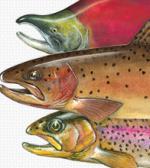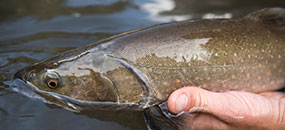TU’s California Program releases new film and video channel, plays role in new proposed flow standards, rules to make water data more accessible and useful. Above photo: Bianchi Flowers Farm, Pescadero Creek, California central coast
By Brian J. Johnson
As summer turns to fall, we come to the most critical time of the year for trout and salmon in many California streams. It’s the peak of our dry season, and many coastal and tributary streams are now mere trickles or completely dewatered.
However, recent developments in this state provide reason for optimism in efforts to conserve and restore our cold water fish species. These developments highlight three things vital for success in this endeavor.
(R) The lower Tuolumne RiverOne is the importance of utilizing the best available data and science to better inform our decisions about how to allocate one of our most precious resources. Another is the importance of engaging in the process of managing and relicensing dam operations to ensure good outcomes for fish. The third is the importance of partnerships in developing water solutions that work equally for people and the environment.
A key constraint to sustainable water management in California is the inability of water managers and users to harness existing information about available supplies, environmental needs, and the value of water. TU has been advocating both in Sacramento and in Washington for new measures that will make it easier to access, share, and utilize water data—this will facilitate more informed decisions and permit development of a more efficient water market.
Our efforts were rewarded when the legislature passed and Governor Brown signed A.B. 1755, the Open and Transparent Water Data Act, this year. A.B. 1755 requires the state to bring together existing water and ecological data from different agencies into a statewide integrated water data platform.
(L) The lower Merced RiverOn September 15, the State Water Board released a draft Substitute Environmental Document (SED) which proposes new streamflow goals and standards for the lower San Joaquin River and its three main tributaries, the Merced, Tuolumne, and Stanislaus Rivers. The proposed new flow standards could significantly help the dwindling salmon and steelhead runs in these rivers.
This is the first proposal to update flow and water quality standards in these rivers since 1995 and is long overdue. In the meantime, salmon and steelhead populations in these waters have declined dramatically. The draft SED proposes a range of minimum required flows, with an initial target of 40 percent of “unimpaired” (with no human withdrawal) flows. These flows standards could be adjusted upward or downward depending on future circumstances.
Currently, in an average year 70% of unimpaired flows are diverted in these rivers and in some periods more than 90% is diverted. According to the California Department of Fish and Wildlife (2013) and the SWRCB’s 2010 Public Trust Flows report, 50-60% of unimpaired flows are necessary to restore these rivers and their salmon and steelhead populations.
Trout Unlimited has been engaged in the process of developing the SED since its inception, largely through Chandra Ferrari, our Water Policy Director, and Rene Henery, our Science Director. Click here for TU’s statement on the release of the draft SED, and our previous comments on the SED can be found here.
The present level of diversions is unsustainable if we are to conserve our dwindling Central Valley salmon and steelhead runs. While lack of water is not the only variable driving salmon and steelhead declines, it is the master variable. Other factors that influence fish populations (predation, habitat loss and degradation, water quality) will all be improved with better flows.
(R) The Steelhead Whisperer, Pescadero Creek lagoon, not far downstream of the Bianchi Flowers Farm projectConsistent with TU’s pragmatic and opportunistic approach to conservation, TU in California dedicates as much or more resources to on-the-ground restoration and streamflow restoration projects as we do to big-picture policy solutions. Our work with the Bianchi Flowers Farm in the Pescadero Creek watershed showcases the benefits for fish of this work.
Pescadero Creek is one of the last wild steelhead strongholds on the central coast. Our partnership with the Burns family has produced a customized water solution that provides greater water security for the farm and leaves over 13 million gallons of water in the creek during the dry season. Learn more about this project and watch our new short film about it here.
The Bianchi Flowers/Pescadero Creek project is the latest in a series of such projects developed by our Coastal Streamflow Stewardship Program. We have produced short documentary films about several of these projects and recently launched a new channel on Vimeo to house them.
Conservation is an exercise in hope. Sometimes nature provide the spark for optimism—a wetter than average winter, perhaps. Other times it is milestones reached in the steady, incremental work of people trying to save our natural heritage for future generations.
Over the past few months, TU had a hand in the conservation milestones described above. But we are nowhere near where we need to be in order to have fishable runs of wild salmon and steelhead across their native range. So we catch our breath, and put our shoulders to the wheel again.
Brian Johnson is director of TU's California and Klamath programs, and Senior Attorney.









